Study Reviews and Rethinking the Key Processes for Managing Building Materials to Enhance the Circular Economy in the AEC Industry
Abstract
1. Introduction
2. State-of-the-Art
2.1. Theories and Tools Related to BC
2.2. Past Studies on BC Influencing Factors
2.3. Research Gap
3. Methodology
4. Key Processes in Managing Building Materials
4.1. Pre-Treatment
4.2. Composition
4.3. Decomposition
4.4. Post-Treatment
5. Further Analyses with Examples
5.1. Concrete Components
5.2. Wall Details
6. Discussion
6.1. Material Changes in Building Operation
6.2. Contributions of the Study
7. Conclusions
Author Contributions
Funding
Institutional Review Board Statement
Informed Consent Statement
Data Availability Statement
Conflicts of Interest
References
- Marris, S. Oecd trade with the newly industrialising countries (NICS). OECD Obs. 1979, 99, 28. [Google Scholar]
- Wang, H. Urbanisation makes a positive contribution to ecological improvement in China. China Sci. News 2022, 3. Available online: https://kns.cnki.net/kcms/detail/detail.aspx?dbcode=CCND&dbname=CCNDLAST2022&filename=KXSB202202240030&uniplatform=NZKPT&v=_HkV7iKrbtFFlhmPazxmYyzGtH5JA5ljJGcKG-Y_YaxkLJ0_CCIklCYo7HmyJkMPKgpXhAGoymM%3d (accessed on 11 August 2022).
- Ye, B.; Yuan, H. An overview of C&D waste management regulations in Central China. In Proceedings of the ICCREM 2014: Smart Construction and Management in the Context of New Technology, Kunming, China, 27–28 September 2014; pp. 45–52. [Google Scholar]
- Duan, H.; Miller, T.R.; Liu, G.; Tam, V.W. Construction debris becomes growing concern of growing cities. Waste Manag. 2019, 83, 1–5. [Google Scholar] [CrossRef]
- Rosado, L.P.; Vitale, P.; Penteado, C.S.; Arena, U. Life cycle assessment of construction and demolition waste management in a large area of São Paulo State, Brazil. Waste Manag. 2019, 85, 477–489. [Google Scholar] [CrossRef] [PubMed]
- Wang, J.; Li, Z.; Tam, V.W. Critical factors in effective construction waste minimization at the design stage: A Shenzhen case study, China. Resour. Conserv. Recycl. 2014, 82, 1–7. [Google Scholar] [CrossRef]
- Bao, Z.; Lu, W. Developing efficient circularity for construction and demolition waste management in fast emerging economies: Lessons learned from Shenzhen, China. Sci. Total Environ. 2020, 724, 138264. [Google Scholar] [CrossRef]
- Hemidat, S.; Achouri, O.; El Fels, L.; Elagroudy, S.; Hafidi, M.; Chaouki, B.; Ahmed, M.; Hodgkinson, I.; Guo, J. Solid Waste Management in the Context of a Circular Economy in the MENA Region. Sustainability 2022, 14, 480. [Google Scholar] [CrossRef]
- Córdoba, R.E.; Marques, J.d.C.; Santiago, C.D.; Pugliesi, E.; Schalch, V. Alternative construction and demolition (C&D) waste characterization method proposal. Eng. Sanit. Ambient. 2019, 24, 199–212. [Google Scholar]
- Gao, Q.; Lei, Q.; He, H. The reason and countermeasure of the slow development of construction waste recycling industry in China. Ecol. Econ. 2012, 12, 128–135. [Google Scholar]
- Huang, B.; Wang, X.; Kua, H.; Geng, Y.; Bleischwitz, R.; Ren, J. Construction and demolition waste management in China through the 3R principle. Resour. Conserv. Recycl. 2018, 129, 36–44. [Google Scholar] [CrossRef]
- Yang, H.; Huang, X.; Thompson, J.R.; Bright, R.M.; Astrup, R. The crushing weight of urban waste. Science 2016, 351, 674. [Google Scholar] [CrossRef]
- Yang, H.; Xia, J.; Thompson, J.R.; Flower, R.J. Urban construction and demolition waste and landfill failure in Shenzhen, China. Waste Manag. 2017, 63, 393–396. [Google Scholar] [CrossRef] [PubMed]
- Belayutham, S.; Gonzalez, V.A.; Yiu, T.W. A cleaner production-pollution prevention based framework for construction site induced water pollution. J. Clean. Prod. 2016, 135, 1363–1378. [Google Scholar] [CrossRef]
- Heard, R.; Hendrickson, C.; McMichael, F.C. Sustainable development and physical infrastructure materials. MRS Bull. 2012, 37, 389–394. [Google Scholar] [CrossRef]
- Sassi, P. Defining closed-loop material cycle construction. Build. Res. Inf. 2008, 36, 509–519. [Google Scholar] [CrossRef]
- Akanbi, L.A.; Oyedele, L.O.; Omoteso, K.; Bilal, M.; Akinade, O.O.; Ajayi, A.O.; Delgado, J.M.D.; Owolabi, H.A. Disassembly and deconstruction analytics system (D-DAS) for construction in a circular economy. J. Clean. Prod. 2019, 223, 386–396. [Google Scholar] [CrossRef]
- Lieder, M.; Rashid, A. Towards circular economy implementation: A comprehensive review in context of manufacturing industry. J. Clean. Prod. 2016, 115, 36–51. [Google Scholar] [CrossRef]
- Van Buren, N.; Demmers, M.; Van der Heijden, R.; Witlox, F. Towards a circular economy: The role of Dutch logistics industries and governments. Sustainability 2016, 8, 647. [Google Scholar] [CrossRef]
- Joensuu, T.; Edelman, H.; Saari, A. Circular economy practices in the built environment. J. Clean. Prod. 2020, 276, 124215. [Google Scholar] [CrossRef]
- Geissdoerfer, M.; Savaget, P.; Bocken, N.M.; Hultink, E.J. The Circular Economy–A new sustainability paradigm? J. Clean. Prod. 2017, 143, 757–768. [Google Scholar] [CrossRef]
- Li, Y. On the improvement of the basic legal system of circular economy in China. J. Gansu Univ. Political Sci. Law 2010, 3, 80–85. Available online: https://kns.cnki.net/kcms/detail/detail.aspx?dbcode=CJFD&dbname=CJFD2010&filename=GSZF201003016&uniplatform=NZKPT&v=VKCJYnYH46PyOAMRiDtqYX01zG7Vc42eWlarTNKgeycSY3PlzBweIDiyVhQjYCue (accessed on 11 August 2022).
- Khadim, N.; Agliata, R.; Marino, A.; Thaheem, M.J.; Mollo, L. Critical review of nano and micro-level building circularity indicators and frameworks. J. Clean. Prod. 2022, 357, 131859. [Google Scholar] [CrossRef]
- Van Dijk, S.; Tenpierik, M.; Van Den Dobbelsteen, A. Continuing the building’s cycles: A literature review and analysis of current systems theories in comparison with the theory of Cradle to Cradle. Resour. Conserv. Recycl. 2014, 82, 21–34. [Google Scholar] [CrossRef]
- McDonough, W.; Braungart, M. Cradle to cradle: Remaking the Way We Make Things; North Point Press: New York, NY, USA, 2002. [Google Scholar]
- Markova, S.; Rechberger, H. Entwicklung Eines Konzepts zur Förderung der Kreislaufwirtschaft im Bauwesen: Materieller Gebäudepass und Design for Recycling Für das Bauwesen; Technische Universität Wien (TU Wien): Vienna, Austria, 2011. [Google Scholar]
- Munaro, M.R.; Tavares, S.F. Materials passport’s review: Challenges and opportunities toward a circular economy building sector. Built Environ. Proj. Asset Manag. 2021, 11, 767–782. [Google Scholar] [CrossRef]
- Luscuere, L.M. Materials Passports: Optimising value recovery from materials. Waste Resour. Manag 2017, 170, 25–28. [Google Scholar] [CrossRef]
- Smeets, A.; Wang, K.; Drewniok, M.P. Can Material Passports lower financial barriers for structural steel re-use? IOP Conf. Ser. Earth Environ. Sci. 2019, 225, 012006. [Google Scholar] [CrossRef]
- Heisel, F.; Rau-Oberhuber, S. Calculation and evaluation of circularity indicators for the built environment using the case studies of UMAR and Madaster. J. Clean. Prod. 2020, 243, 118482. [Google Scholar] [CrossRef]
- Rose, C.M.; Stegemann, J.A. Characterising existing buildings as material banks (E-BAMB) to enable component reuse. Proc. Inst. Civ. Eng. Eng. Sustain. 2018, 172, 129–140. [Google Scholar] [CrossRef]
- Cai, G.; Waldmann, D. A material and component bank to facilitate material recycling and component reuse for a sustainable construction: Concept and preliminary study. Clean Technol. Environ. Policy 2019, 21, 2015–2032. [Google Scholar] [CrossRef]
- Boothroyd, G.; Poli, C.; Murch, L. Feeding and Orienting Techniques for Small Parts; Department of Mechanical Engineering, University of Massachusetts: Amherst, MA, USA, 1977. [Google Scholar]
- Boothroyd, G.; Dewhurst, P. Design for Assembly: A Designer’s Handbook; Department of Mechanical Engineering, University of Massachusetts: Amherst, MA, USA, 1983. [Google Scholar]
- Kuo, T.-C.; Huang, S.H.; Zhang, H.-C. Design for manufacture and design for ‘X’: Concepts, applications, and perspectives. Comput. Ind. Eng. 2001, 41, 241–260. [Google Scholar] [CrossRef]
- Gatenby, D.; Foo, A. Design for X: Key to competitive, Profitable products. ATT Tech. J. 1999, 69, 2–13. [Google Scholar] [CrossRef]
- Crowther, P. Designing for disassembly. In Technology, Design and Process Innovation in the Built Environment; Spon Press: London, UK, 2009; Volume 10, p. 224. [Google Scholar]
- Akinade, O.O.; Oyedele, L.O.; Ajayi, S.O.; Bilal, M.; Alaka, H.A.; Owolabi, H.A.; Bello, S.A.; Jaiyeoba, B.E.; Kadiri, K.O. Design for Deconstruction (DfD): Critical success factors for diverting end-of-life waste from landfills. Waste Manag. 2017, 60, 3–13. [Google Scholar] [CrossRef] [PubMed]
- ISO 14040:2006; Environmental Management: Life Cycle Assessment—Principles and Framework. ISO: Geneva, Switzerland, 2006. Available online: https://www.iso.org/standard/37456.html (accessed on 11 August 2022).
- Ortiz, O.; Castells, F.; Sonnemann, G. Sustainability in the construction industry: A review of recent developments based on LCA. Constr. Build. Mater. 2009, 23, 28–39. [Google Scholar] [CrossRef]
- Minunno, R.; O’Grady, T.; Morrison, G.M.; Gruner, R.L. Exploring environmental benefits of reuse and recycle practices: A circular economy case study of a modular building. Resour. Conserv. Recycl. 2020, 160, 104855. [Google Scholar] [CrossRef]
- Ding, T.; Xiao, J.; Tam, V.W. A closed-loop life cycle assessment of recycled aggregate concrete utilization in China. Waste Manag. 2016, 56, 367–375. [Google Scholar] [CrossRef] [PubMed]
- Malabi Eberhardt, L.C.; van Stijn, A.; Nygaard Rasmussen, F.; Birkved, M.; Birgisdottir, H. Development of a life cycle assessment allocation approach for circular economy in the built environment. Sustainability 2020, 12, 9579. [Google Scholar] [CrossRef]
- Finch, G.; Marriage, G.; Pelosi, A.; Gjerde, M. Building envelope systems for the circular economy; Evaluation parameters, current performance and key challenges. Sustain. Cities Soc. 2021, 64, 102561. [Google Scholar] [CrossRef]
- Dokter, G.; Thuvander, L.; Rahe, U. How circular is current design practice? Investigating perspectives across industrial design and architecture in the transition towards a circular economy. Sustain. Prod. Consum. 2021, 26, 692–708. [Google Scholar] [CrossRef]
- Eberhardt, L.C.M.; Birgisdottir, H.; Birkved, M. Potential of circular economy in sustainable buildings. IOP Conf. Ser. Mater. Sci. Eng. 2019, 471, 092051. [Google Scholar] [CrossRef]
- Braakman, L.; Bhochhibhoya, S.; de Graaf, R. Exploring the relationship between the level of circularity and the life cycle costs of a one-family house. Resour. Conserv. Recycl. 2021, 164, 105149. [Google Scholar] [CrossRef]
- Mayer, M. Adapting residential envelope assemblies for full circularity. J. Phys. Conf. Ser. 2021, 2042, 012170. [Google Scholar] [CrossRef]
- Kanters, J. Design for deconstruction in the design process: State of the art. Buildings 2018, 8, 150. [Google Scholar] [CrossRef]
- Akinade, O.O.; Oyedele, L.O.; Bilal, M.; Ajayi, S.O.; Owolabi, H.A.; Alaka, H.A.; Bello, S.A. Waste minimisation through deconstruction: A BIM based Deconstructability Assessment Score (BIM-DAS). Resour. Conserv. Recycl. 2015, 105, 167–176. [Google Scholar] [CrossRef]
- Bertino, G.; Kisser, J.; Zeilinger, J.; Langergraber, G.; Fischer, T.; Österreicher, D. Fundamentals of building deconstruction as a circular economy strategy for the reuse of construction materials. Appl. Sci. 2021, 11, 939. [Google Scholar] [CrossRef]
- Schultmann, F.; Sunke, N. Energy-oriented deconstruction and recovery planning. Build. Res. Inf. 2007, 35, 602–615. [Google Scholar] [CrossRef]
- Sagan, J.; Sobotka, A. Analysis of Factors Affecting the Circularity of Building Materials. Materials 2021, 14, 7296. [Google Scholar] [CrossRef]
- Gálvez-Martos, J.-L.; Styles, D.; Schoenberger, H.; Zeschmar-Lahl, B. Construction and demolition waste best management practice in Europe. Resour. Conserv. Recycl. 2018, 136, 166–178. [Google Scholar] [CrossRef]
- Kartam, N.; Al-Mutairi, N.; Al-Ghusain, I.; Al-Humoud, J. Environmental management of construction and demolition waste in Kuwait. Waste Manag. 2004, 24, 1049–1059. [Google Scholar] [CrossRef]
- Pun, S.K.; Liu, C.; Li, J. Salvage material logistics management for building demolition project. In Proceeding of the International Conference on Transportation Logistics, Singapore, 27–29 July 2005; pp. 1–10. [Google Scholar]
- Shooshtarian, S.; Caldera, S.; Maqsood, T.; Ryley, T. Using recycled construction and demolition waste products: A review of stakeholders’ perceptions, decisions, and motivations. Recycling 2020, 5, 31. [Google Scholar] [CrossRef]
- Sassi, P. Designing buildings to close the material resource loop. Proc. Inst. Civ. Eng. Eng. Sustain. 2004, 157, 163–171. [Google Scholar] [CrossRef]
- Kostakis, I.; Tsagarakis, K.P. Social and economic determinants of materials recycling and circularity in Europe: An empirical investigation. Ann. Reg. Sci. 2022, 68, 263–281. [Google Scholar] [CrossRef]
- Towa, E.; Zeller, V.; Achten, W.M. Assessing the circularity of regions: Stakes of trade of waste for treatment. J. Ind. Ecol. 2021, 25, 834–847. [Google Scholar] [CrossRef]
- Zhang, N.; Han, Q.; de Vries, B. Building Circularity Assessment in the Architecture, Engineering, and Construction Industry: A New Framework. Sustainability 2021, 13, 12466. [Google Scholar] [CrossRef]
- Foundation, E.M. An Approach to Measuring Circularity-Methodology. 2015. Available online: http://susdi.org/doc/CE/CIRCULAR%20IMPACTS%20-%20CIRCULARITY%20INDICATORS_%20An%20Approach%20to%20Measuring%20Circularity_%20METHODOLOGY%20-%202018-01-25.pdf (accessed on 11 August 2022).
- Hendriks, C.F.; Te Dorsthorst, B. Re-Use of Constructions at Different Levels: Construction, Element or Material; CIB World Building Congress: Wellington, New Zealand; Citeseer: Wellington, New Zealand, 2001. [Google Scholar]
- Morgan, C.; Stevenson, F. Design for Deconstruction SEDA Design Guides for Scotland: No. 1; Scottish Executive, Scottish Ecological Design Association: Edinburgh, UK, 2005. [Google Scholar]
- Brown, M.; Buranakarn, V. Emergy indices and ratios for sustainable material cycles and recycle options. Resour. Conserv. Recycl. 2003, 38, 1–22. [Google Scholar] [CrossRef]
- Iacovidou, E.; Purnell, P. Mining the physical infrastructure: Opportunities, barriers and interventions in promoting structural components reuse. Sci. Total Environ. 2016, 557, 791–807. [Google Scholar] [CrossRef] [PubMed]
- Azambuja, R.d.R.; Castro, V.G.d.; Trianoski, R.; Iwakiri, S. Recycling wood waste from construction and demolition to produce particleboards. Maderas. Cienc. Tecnol. 2018, 20, 681–690. [Google Scholar] [CrossRef]
- Hasan, A.R.; Schindler, J.; Solo-Gabriele, H.M.; Townsend, T.G. Online sorting of recovered wood waste by automated XRF-technology. Part I: Detection of preservative-treated wood waste. Waste Manag. 2011, 31, 688–694. [Google Scholar] [CrossRef]
- Chen, A.Y.-Y.; Olsen, T. Chromated copper arsenate–treated wood: A potential source of arsenic exposure and toxicity in dermatology. Int. J. Women’s Dermatol. 2016, 2, 28–30. [Google Scholar] [CrossRef]
- Saxe, J.K.; Wannamaker, E.J.; Conklin, S.W.; Shupe, T.F.; Beck, B.D. Evaluating landfill disposal of chromated copper arsenate (CCA) treated wood and potential effects on groundwater: Evidence from Florida. Chemosphere 2007, 66, 496–504. [Google Scholar] [CrossRef]
- Pacheco-Torgal, F.; Shahsavandi, A.; Jalali, S. Mechanical properties and durability of concrete with partial replacement of Portland cement by ceramic wastes. In Proceeding of the WASTES: Solutions, Treatments and Opportunities, Guimarães, Portugal, 12–14 September 2011. [Google Scholar]
- Maton, S.M.; Dabi, D.D.; Dodo, J.D.; Nesla, R.A. Forestalling the Continued Depletion of Nigeria’s Mineral Resources through Proper Conservation. Int. J. Sci. Technol. 2016, 4, 103–110. [Google Scholar]
- Babor, D.; Plian, D.; Judele, L. Environmental impact of concrete. Bul. Inst. Politeh. Din Lasi. Sect. Constr. Arhit. 2009, 55, 27. [Google Scholar]
- Jahanshahi, R.; Zare, M. Assessment of heavy metals pollution in groundwater of Golgohar iron ore mine area, Iran. Environ. Earth Sci. 2015, 74, 505–520. [Google Scholar] [CrossRef]
- Anil, Ö.; Togay, A.; Söğütlü, C.; Döngel, N.; Karagöz, Ü.; Ediz, İ. Experimental Analysis of Hysteretic Load Behavior of Timber Framed Shear Walls with Openings. In Proceeding of the 11th International Congress on Advances in Civil Engineering-ACE, Istanbul, Turkey, 21–25 October 2014. [Google Scholar]
- Chen, Z.; Liu, J.; Yu, Y.; Zhou, C.; Yan, R. Experimental study of an innovative modular steel building connection. J. Constr. Steel Res. 2017, 139, 69–82. [Google Scholar] [CrossRef]
- Baran, E.; Mahamid, M.; Baran, M.; Kurtoglu, M.; Torra-Bilal, I. Performance of a moment resisting beam-column connection for precast concrete construction. Eng. Struct. 2021, 246, 113005. [Google Scholar] [CrossRef]
- Vaghei, R.; Hejazi, F.; Taheri, H.; Jaafar, M.S.; Aziz, F.N.A.A. Development of a new connection for precast concrete walls subjected to cyclic loading. Earthq. Eng. Eng. Vibr. 2017, 16, 97–117. [Google Scholar] [CrossRef]
- Cheng, J. Testing and analysis of the toe-nailed connection in the residential roof-to-wall system. For. Prod. J. 2004, 54, 58–65. [Google Scholar]
- Ma, L.; Xue, J.; Dai, W.; Zhang, X.; Zhao, X. Moment-rotation relationship of mortise-through-tenon connections in historic timber structures. Constr. Build. Mater. 2020, 232, 117285. [Google Scholar] [CrossRef]
- Galassi, S.; Dipasquale, L.; Ruggieri, N.; Tempesta, G. Andalusian timber roof structure in Chefchaouen, Northern Morocco: Construction technique and structural behavior. J. Archit. Eng. 2018, 24, 04018012. [Google Scholar] [CrossRef]
- Choi, H.-K.; Choi, Y.-C.; Choi, C.-S. Development and testing of precast concrete beam-to-column connections. Eng. Struct. 2013, 56, 1820–1835. [Google Scholar] [CrossRef]
- Mohammed, A.A.; Mohammed, O.K. Composite concrete–Unregularized timber section for flat roof construction. Structures 2020, 27, 1324–1334. [Google Scholar] [CrossRef]
- Canbek, C.; Mirmiran, A.; Chowdhury, A.G.; Suksawang, N. Development of fiber-reinforced polymer roof-to-wall connection. J. Compos. Constr. 2011, 15, 644–652. [Google Scholar] [CrossRef]
- Boothroyd, G.; Alting, L. Design for assembly and disassembly. CIRP Ann. 1992, 41, 625–636. [Google Scholar] [CrossRef]
- Morgan, C.; Stevenson, F. Design and Detailing for Deconstruction: SEDA Design Guide for Scotland; Scottish Executive, Scottish Ecological Design Association: Edinburgh, UK, 2005. [Google Scholar]
- Crowther, P. Developing Guidelines for Designing for Deconstruction. In Deconstruction-Closing the Loop Conference Proceedings; Building Research Council: Watford, UK, 2000. [Google Scholar]
- Xiao, J.; Chen, L.; Ye, J.; Lan, W.; Zeng, L. Technology and Green Development of Demolition for Concrete Structures. J. Archit. Civ. Eng. 2019, 36, 1–10. Available online: https://kns.cnki.net/kcms/detail/detail.aspx?dbcode=CJFD&dbname=CJFDLAST2019&filename=XBJG201905002&uniplatform=NZKPT&v=Noq24ajEcrFdifCZtslUeZDdOCD2eHZ2VazrRDJbBNiptc4J136A_thGtozeKej9 (accessed on 11 August 2022).
- Coelho, A. Conventional demolition versus deconstruction techniques in managing construction and demolition waste (CDW). In Handbook of Recycled Concrete and Demolition Waste; Pacheco-Torgal, F., Tam, V.W.Y., Labrincha, J.A., Ding, Y., Brito, J.D., Eds.; Elsevier: Amsterdam, The Netherlands, 2013; pp. 141–185. [Google Scholar]
- Chini, A.R.; Bruening, S. Deconstruction and materials reuse in the United States. Future Sustain. Constr. 2003, 14, pagination. [Google Scholar]
- Lee, S.; Pan, W.; Linner, T.; Bock, T. A framework for robot assisted deconstruction: Process, sub-systems and modelling. In Proceedings of the 32nd ISARC: Proceedings of the International Symposium on Automation and Robotics in Construction, Oulu, Finland, 15–18 June 2015. [Google Scholar]
- Lublasser, E.; Hildebrand, L.; Vollpracht, A.; Brell-Cokcan, S. Robot assisted deconstruction of multi-layered façade constructions on the example of external thermal insulation composite systems. Constr. Robot. 2017, 1, 39–47. [Google Scholar] [CrossRef]
- Yang, Y.; Hu, J.; Liu, X.; Dai, J.; Yao, Y. Analysis of ground vibration characteristics caused by blasting demolition of high-rise buildings. Build. Struct. 2021, 51 (Suppl. 2), 1446–1450. Available online: https://kns.cnki.net/kcms/detail/detail.aspx?dbcode=CJFD&dbname=CJFDLAST2022&filename=JCJG2021S2255&uniplatform=NZKPT&v=Xmv3MT2rnnlakNoPGmTwuX3rmUxfWK8nIY3UHyh0dzlE28H9kYwTrzkvMDWVE9PO (accessed on 11 August 2022).
- Scheerer, S.; Abraham, M.; Madden, O. Study of the effects of laser radiation on epoxy resins and epoxy systems on stone, ceramic, and glass surfaces. J. Cult. Herit. 2003, 4, 223–229. [Google Scholar] [CrossRef]
- Chileshe, N.; Jayasinghe, R.S.; Rameezdeen, R. Information flow-centric approach for reverse logistics supply chains. Autom. Constr. 2019, 106, 102858. [Google Scholar] [CrossRef]
- Romaniega Piñeiro, S.; del Río Merino, M.; Pérez García, C. New plaster composite with mineral wool fibres from CDW recycling. Adv. Mater. Sci. Eng. 2015, 2015, 854192. [Google Scholar] [CrossRef]
- European Environment Agency. Communication from the Commission to the European Parliament, the Council, the European Economic and Social Committee and the Committee of the Regions. A Roadmap for Moving to a Competitive Low Carbon Economy in 2050; European Environment Agency: Copenhagen, Denmark, 2011; Available online: https://www.staten-generaal.nl/9370000/1/j4nvi0xeni9vr2l_j9vvkfvj6b325az/vl82fmx00szx/f=/vl5ccnyjpptu.pdf (accessed on 11 August 2022).
- Pariathamby, A.; Bhatti, M.S. Issues and Challenges in Sustainable Solid Waste Management: Global and Asian Perspective. In Advances in Waste-to-Energy Technologies; CRC Press: Boca Raton, FL, USA, 2019; pp. 21–40. [Google Scholar]
- Di Maria, A.; Eyckmans, J.; Van Acker, K. Downcycling versus recycling of construction and demolition waste: Combining LCA and LCC to support sustainable policy making. Waste Manag. 2018, 75, 3–21. [Google Scholar] [CrossRef]
- Zhang, C.; Hu, M.; Yang, X.; Miranda-Xicotencatl, B.; Sprecher, B.; Di Maio, F.; Zhong, X.; Tukker, A. Upgrading construction and demolition waste management from downcycling to recycling in the Netherlands. J. Clean. Prod. 2020, 266, 121718. [Google Scholar] [CrossRef]
- Liu, H.; Long, H.; Li, X. Identification of critical factors in construction and demolition waste recycling by the grey-DEMATEL approach: A Chinese perspective. Environ. Sci. Pollut. Res. 2020, 27, 8507–8525. [Google Scholar] [CrossRef] [PubMed]
- Hobbs, G.; Hurley, J. Deconstruction and the reuse of construction materials. In Proceedings of the CIB Task Group 39—Deconstruction Meeting CIB World Building Congress, Wellington, New Zealand, 6 April 2001. [Google Scholar]
- Glias, A. The “Donor Skelet”: Designing with Reused Structural Concrete Elements; Delft University of Technology: Delft, The Netherlands, 2013. [Google Scholar]
- Sun, Y.; Sun, K.; Guo, Y. Use and performance research of recycled concrete. Concrete 2010, 3, 105–107. [Google Scholar]
- Xi, F.; Tang, D.; Sun, Y. Study on System Design of Small Prefabricated Wood-Plastic Buildings. China For. Prod. Ind. 2021, 58, 45–49, 64. Available online: https://kns.cnki.net/kcms/detail/detail.aspx?dbcode=CJFD&dbname=CJFDLAST2021&filename=LCGY202107009&uniplatform=NZKPT&v=4Bq6K-LliCzN97sQJjajuRrdfZYJlXMHDUz08LwAD8GW_gJnJ4ezoNkN6FtbjlJP (accessed on 11 August 2022).
- Qu, Z.; Fu, X.; Kishiki, S.; Cui, Y. Behavior of masonry infilled Chuandou timber frames subjected to in-plane cyclic loading. Eng. Struct. 2020, 211, 110449. [Google Scholar] [CrossRef]
- Yuwen, B.; Yang, X. Research Application of building Structure Insulation Integration Technology. Sichuan Cem. 2022, 2, 145–146, 149. Available online: https://kns.cnki.net/kcms/detail/detail.aspx?dbcode=CJFD&dbname=CJFDLAST2022&filename=SCSA202202107&uniplatform=NZKPT&v=QMrNI5fNU_OxWK4Ke9gApimtvt9hZ-odJ_6SnYCGQIXWXeL3MDwlvT3iUzAfRoRX (accessed on 11 August 2022).
- Chen, W.; Liu, K.; Ye, J.; Jiang, J.; Liang, G.; Liu, B. Study on Load-bearing Fire Resistance Test of New Light Steel Composite Wall and Simplification Calculation of Temperature Rise at Thermal Flange of Wall Column. J. Archit. Civ. Eng. 2022, 39, 11–18. Available online: https://kns.cnki.net/kcms/detail/detail.aspx?dbcode=CJFD&dbname=CJFDLAST2022&filename=XBJG202202002&uniplatform=NZKPT&v=kPKWlppbnoz59zC-HwfRjYrljaIxgze0EmNudz9J0twtrQEENJbxmQxO7D6JAqbH (accessed on 11 August 2022).
- Pretot, S.; Collet, F.; Garnier, C. Life cycle assessment of a hemp concrete wall: Impact of thickness and coating. Build. Environ. 2014, 72, 223–231. [Google Scholar] [CrossRef]
- Guo, B.; Guo, Y.; Liu, F.; Li, G.; Chi, Y. Research on cyclic behavior of welded and bolted steel frames. J. Build. Struct. 2006, 2, 47–56. Available online: https://kns.cnki.net/kcms/detail/detail.aspx?dbcode=CJFD&dbname=CJFD2006&filename=JZJB200602007&uniplatform=NZKPT&v=Xkj4O3bNBlxLYb_TfAkz6zOjszlahdvswes7oza08TUefV5fLcXq96cw8l8PYZP4 (accessed on 11 August 2022).

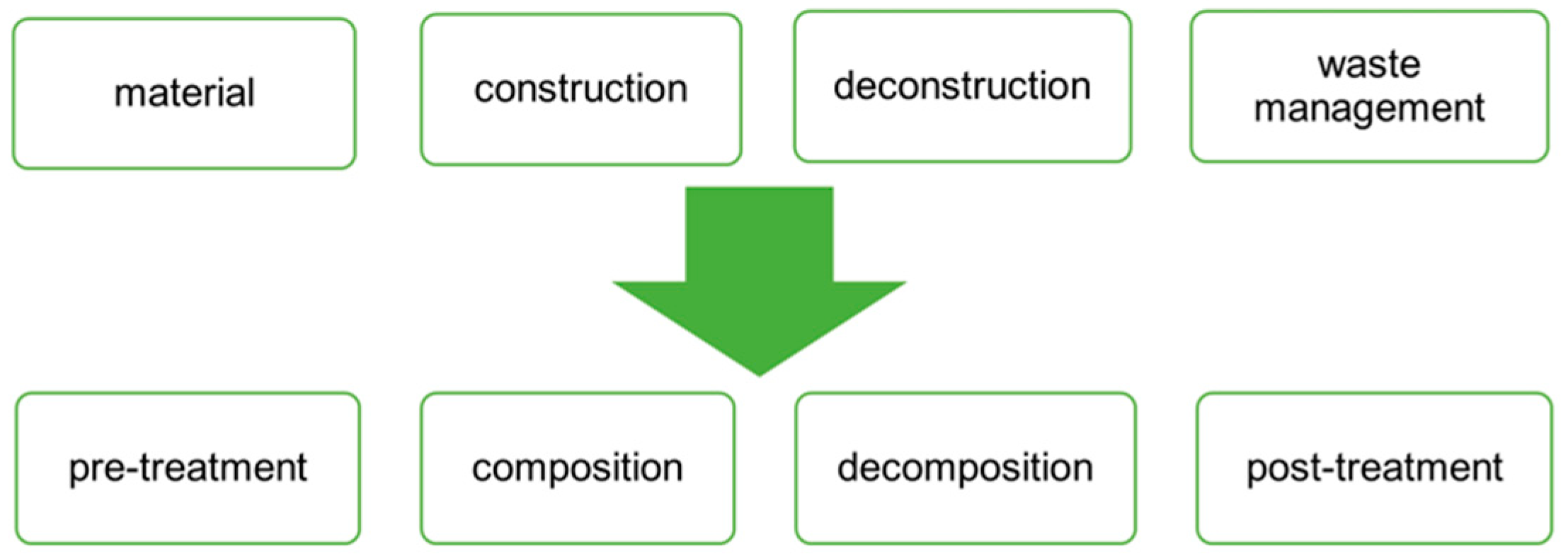
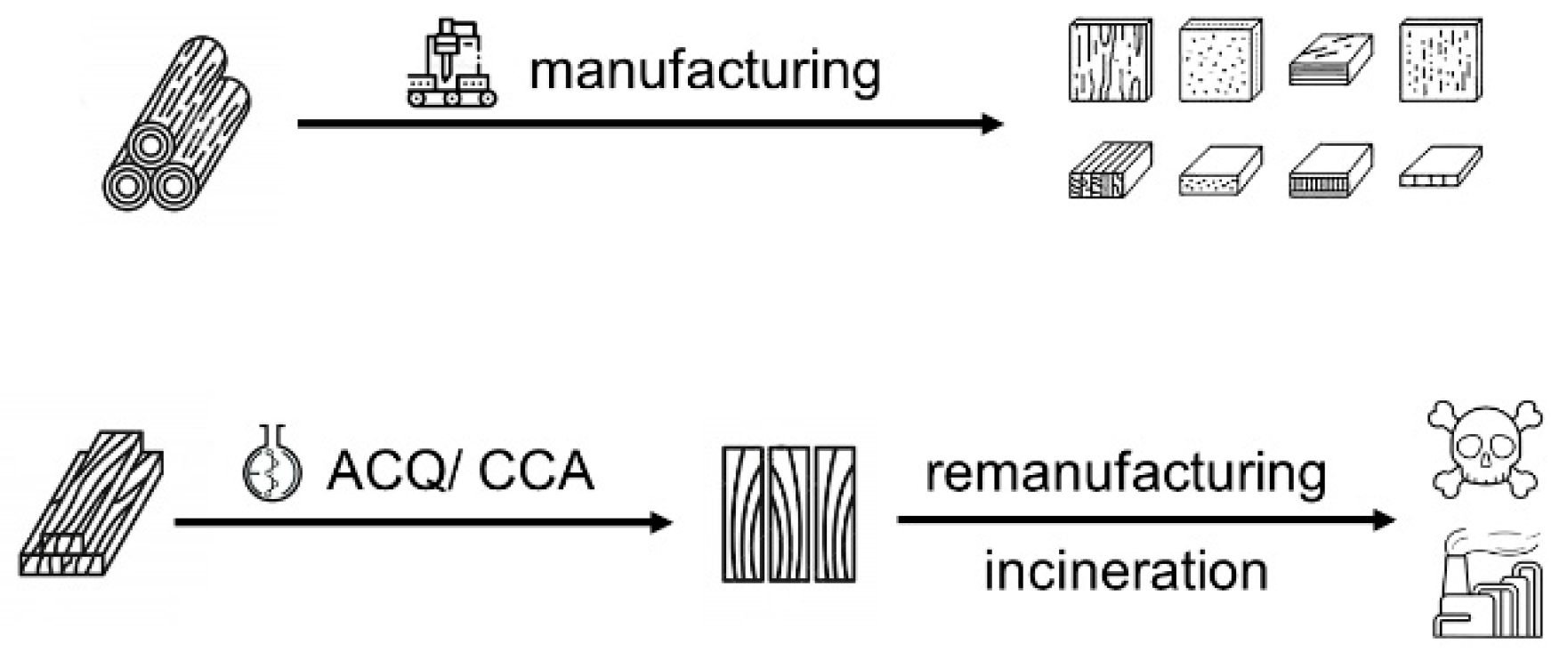
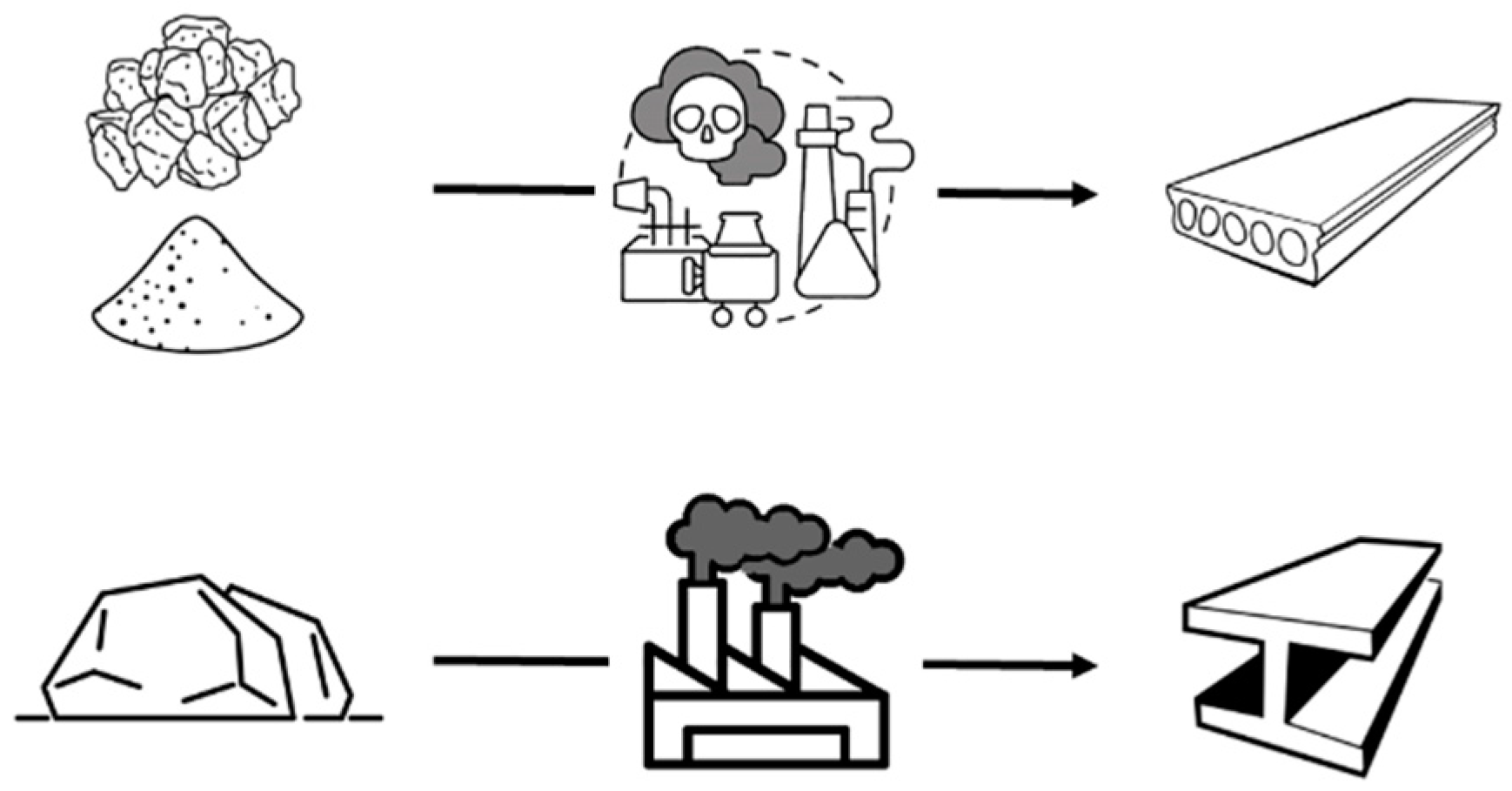
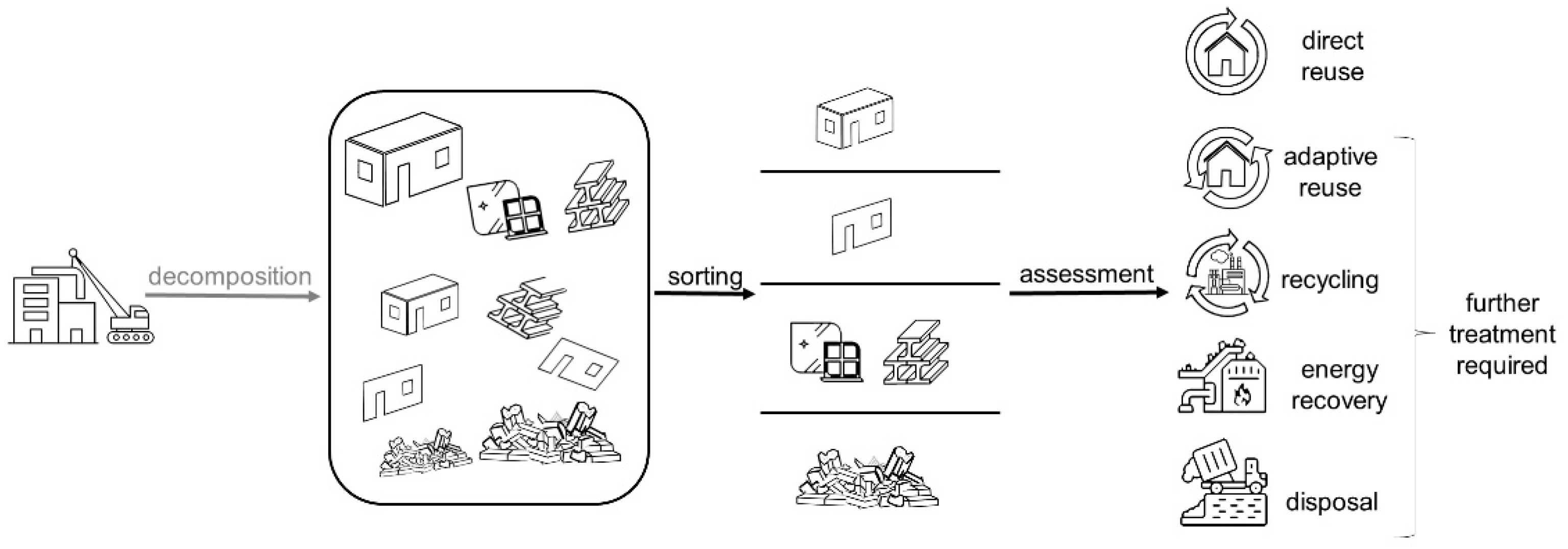
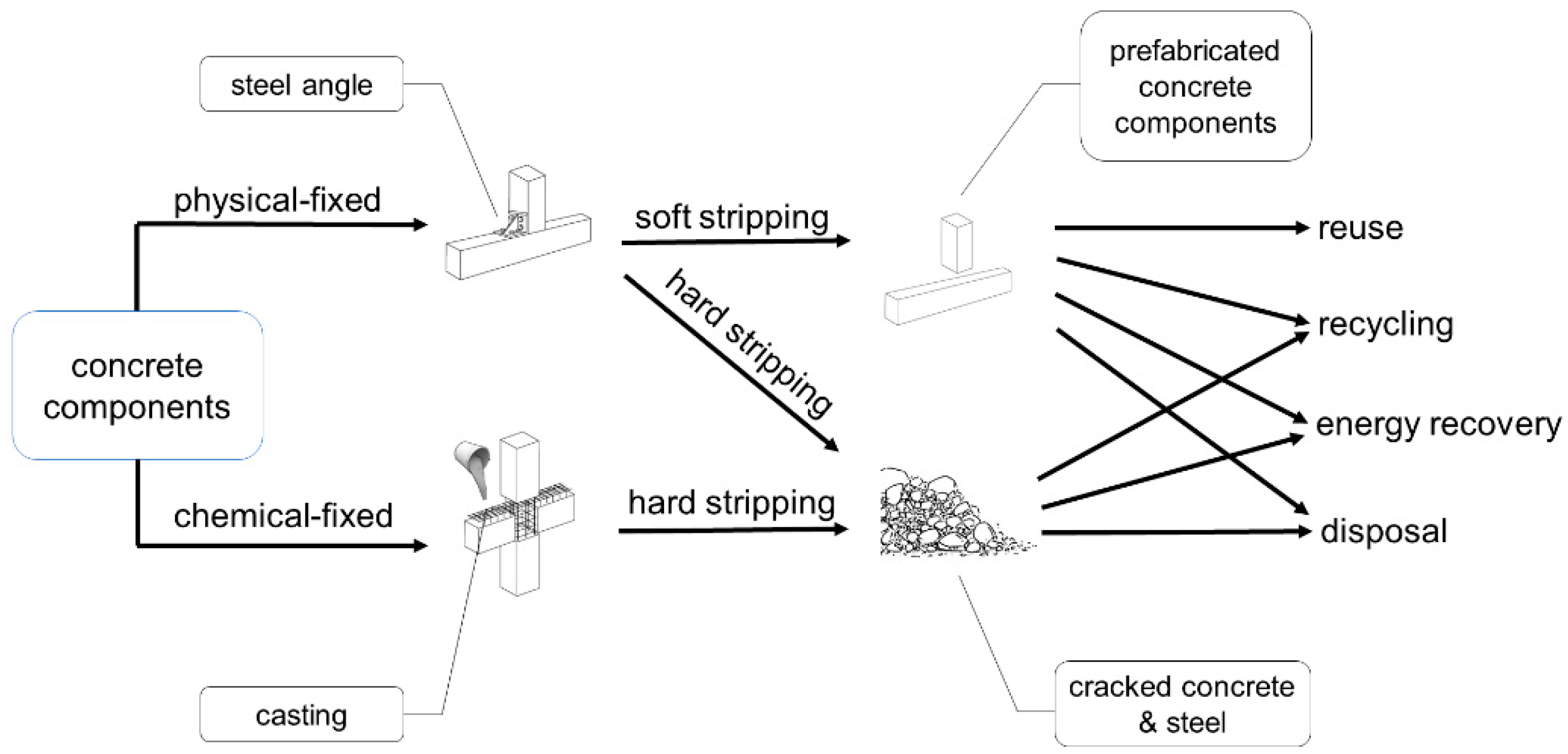
| Literature | Research Focus | |||
|---|---|---|---|---|
| Material | Construction | Deconstruction | Waste Management | |
| Finch, Marriage, Pelosi and Gjerde [44] | √ | |||
| Sassi [16] | √ | |||
| Heisel and Rau-Oberhuber [30] | √ | |||
| Foundation [62] | √ | √ | ||
| Braakman, Bhochhibhoya and de Graaf [47] | √ | |||
| Mayer [48] | √ | |||
| Kanters [49] | √ | |||
| Akinade, Oyedele, Bilal, Ajayi, Owolabi, Alaka and Bello [50] | √ | |||
| Bertino, Kisser, Zeilinger, Langergraber, Fischer and Österreicher [51] | √ | |||
| Schultmann and Sunke [52] | √ | |||
| Sagan and Sobotka [53] | √ | |||
| Hendriks and Te Dorsthorst [63] | √ | |||
| Gálvez-Martos, Styles, Schoenberger and Zeschmar-Lahl [54] | √ | |||
| Kartam, Al-Mutairi, Al-Ghusain and Al-Humoud [55] | √ | |||
| Connection | Reference | ||
|---|---|---|---|
| Type | Position | Method | |
| Physical fixing | OSB sheathing—timber frame | nails | [75] |
| steel module—module | bolts | [76] | |
| prefabricated concrete beam-column | steel plates, top angles, steel threaded rods | [77] | |
| prefabricated concrete wall- wall | steel U-shaped channels, bolts, nuts | [78] | |
| timber roof—wall | toe-nailed | [79] | |
| timber beam—column | mortise-tenon | [80] | |
| Chemical fixing | brick—stone (within masonry wall) | high-grade mortar | [81] |
| steel beam—column | welding | [76] | |
| steel module—module | welding | [76] | |
| prefabricated concrete beam—column | steel connector (consists of bolting steel tubes, steel plates), casting | [82] | |
| concrete plate—beam | steel rivets, casting | [83] | |
| timber roof—wall | high-strength fibre reinforced polymers with epoxy resin | [84] | |
| Tool/Method | Function/Detail | |
|---|---|---|
| Tools for soft stripping | wrench | loosening bolts, separating metal elements |
| bow saw | precise cutting of small wooden elements | |
| pickaxe | breaking stone or brick sections | |
| pliers | cutting cables, dismantling metallic and plastic elements | |
| de-nailing gun | firing small ram to punch nails out | |
| hydraulic scissors | precise dividing of metal, plastic, wood, brick and concrete | |
| Methods for hard stripping | thermal processes | materials are fused and separating structures |
| abrasive processes | the constructed elements are cut into smaller pieces with abrasive saws | |
| chemical processes | using of highly expansive chemicals, causing fragments of constructed elements | |
| electrical processes | discharging through elements, resulting in breakage | |
| explosive | the collapse of a structure with explosives at a critical point of the structure |
| Wall | Element | Connection | Separation | Material | Designation | |
|---|---|---|---|---|---|---|
| A [105] |  | 6 mm timber board 9 mm OSB 20 mm XPS 9 mm OSB | epoxy resin | hard stripping | mixed waste (timber, OSB, XPS, epoxy resin) | energy recovery |
| B [106] |  | Φ170 mm timber columns 50 × 150 mm timber beams 230 × 110 × 50 mm bricks | beams and columns are joined by mortise-tenon; mortar as an adhesive between bricks | soft stripping | timber | reuse |
| hard stripping | mixed waste (bricks, mortar) | recycling | ||||
| C [107] |  | 50 mm concrete 50 mm steel and polystyrene board 50 mm concrete | casting | hard stripping | mixed waste (concrete, polystyrene) | disposal |
| separate steel | recycling | |||||
| D [108] |  | 50 mm concrete board 12 mm CSB 89 mm steel frame 12 mm CSB 0.5 mm steel covering 50 mm concrete board | screws | soft stripping | concrete | reuse |
| steel | reuse | |||||
| CSB | unknow | |||||
| E [109] |  | 10 mm sand and lime coating 24 mm hemp concrete and timber frame 20 mm sand and lime coating | concrete is sprayed onto the timber frame | hard stripping | mixed waste (timber, concrete, sand, lime) | disposal |
| Material | Connection | Separation | Designation | Wall |
|---|---|---|---|---|
| Timber | physical fixing | soft stripping | Reuse | B |
| chemical fixing | hard stripping | Energy recovery | A | |
| Disposal | E | |||
| Concrete | physical fixing | soft stripping | Reuse | D |
| chemical fixing | hard stripping | Disposal | C/E | |
| Steel | physical fixing | soft stripping | Reuse | D |
| chemical fixing | hard stripping | Recycling | C |
Publisher’s Note: MDPI stays neutral with regard to jurisdictional claims in published maps and institutional affiliations. |
© 2022 by the authors. Licensee MDPI, Basel, Switzerland. This article is an open access article distributed under the terms and conditions of the Creative Commons Attribution (CC BY) license (https://creativecommons.org/licenses/by/4.0/).
Share and Cite
Huang, H.; Li, L. Study Reviews and Rethinking the Key Processes for Managing Building Materials to Enhance the Circular Economy in the AEC Industry. Sustainability 2022, 14, 11941. https://doi.org/10.3390/su141911941
Huang H, Li L. Study Reviews and Rethinking the Key Processes for Managing Building Materials to Enhance the Circular Economy in the AEC Industry. Sustainability. 2022; 14(19):11941. https://doi.org/10.3390/su141911941
Chicago/Turabian StyleHuang, Harrison, and Lu Li. 2022. "Study Reviews and Rethinking the Key Processes for Managing Building Materials to Enhance the Circular Economy in the AEC Industry" Sustainability 14, no. 19: 11941. https://doi.org/10.3390/su141911941
APA StyleHuang, H., & Li, L. (2022). Study Reviews and Rethinking the Key Processes for Managing Building Materials to Enhance the Circular Economy in the AEC Industry. Sustainability, 14(19), 11941. https://doi.org/10.3390/su141911941






